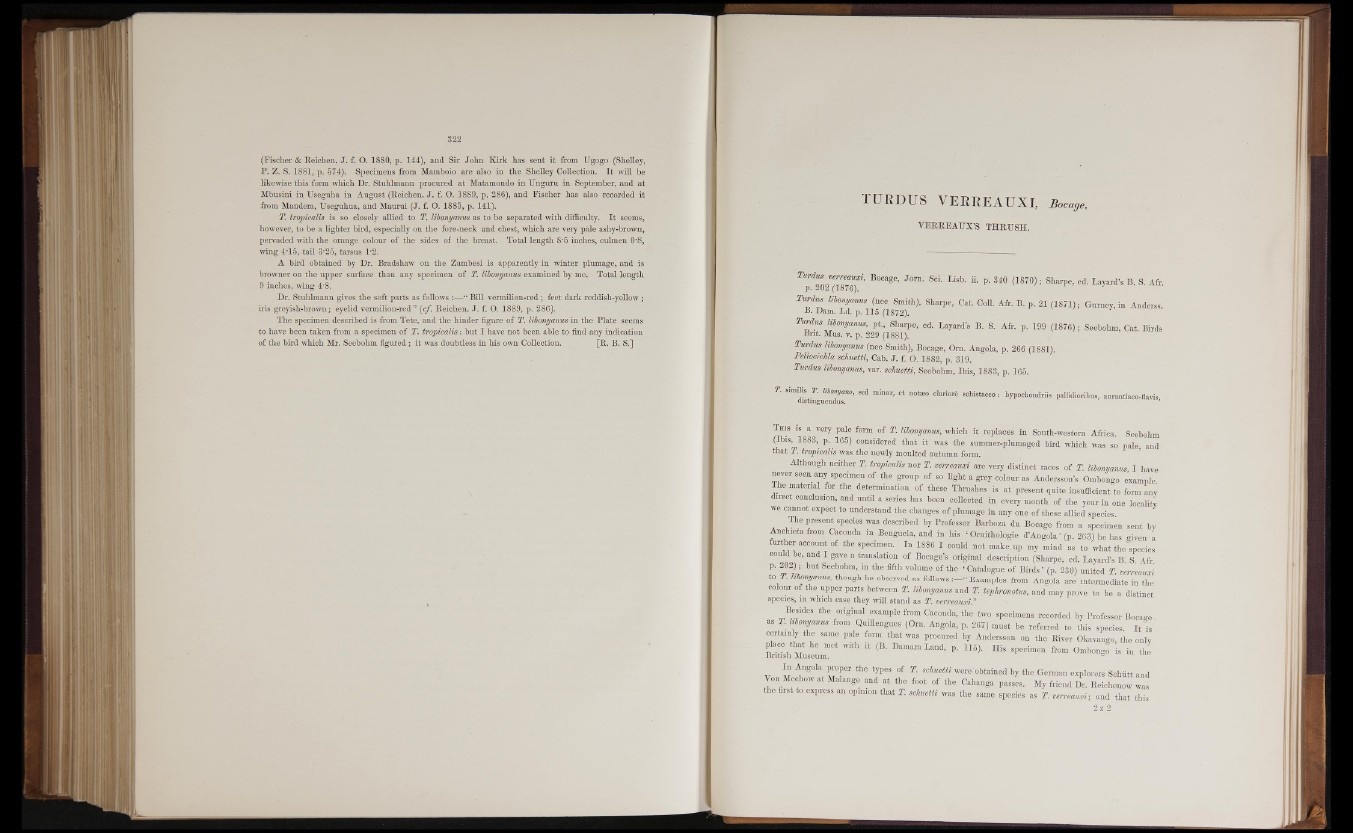
(Fischer & Reichen. J. f. O. 1880, p. 144), and Sir John Kirk has sent it from Ugogo (Shelley,
P. Z. S. 1881, p. 574). Specimens from Mamboio are also in the Shelley Collection. It will be
likewise this form which Dr. Stuhlmann procured at Matamondo in Unguru in September, and at
Mbusini in Useguha in August (Reichen. J. f. O. 1889, p. 286), and Fischer has also recorded it
from Mandera, Useguhua, and Maurui (J. f. O. 1885, p. 141).
T. tropicalis is so closely allied to T. libonyanus as to be separated with difficulty. It seems,
however, to be a lighter bird, especially on the fore-neck and chest, which are very pale ashy-brown,
pervaded with the orange colour of the sides of the breast. Total length S’5 inches, culmen 0*8,
wing 4T5, tail 3*25, tarsus l -2.
A bird obtained by Dr. Bradshaw on the Zambesi is apparently in winter plumage, and is
browner on the upper surface than any specimen of T. libonyanus examined by me. Total length
9 inches, wing 4 8.
Dr. Stuhlmann gives the soft parts as follows :—“ Bill vermilion-red ; feet dark reddish-yellow ;
iris greyish-brown; eyelid vermilion-red” {cf. Reichen. J. f. O. 1889,"p. 286).
The specimen described is from Tete, and the hinder figure of T. libonyanus in the Plate seems
to have been taken from a specimen of T. tropicalis : but I have not been able to find any indication
of the bird which Mr. Seebohm figured ; it was doubtless in his own Collection. [R. B. S.l
TURDUS VERREAUXI, Bocage,
VERREAUX’S THRUSH.
Turdus verreauxi, Bocage, Jom. Sci. Lisb. ii. p. 340 (1870); Sharpe, ed. Layard’s B. S. Afr.
p. 202 (1876).
Turdus libonyanus (nec Smith), Sharpe, Oat. Coll. Afr. B. p. 21 (1871); Gurney, in Anderss.
B. Dam. Ld. p. 115 (1872).
Turdus libonyanus, pt„ Sharpe, ed. Layard’s B. S. Afr. p. 199 (1876); Seebohm, Cat. Birds
Bnt. Mus. v. p. 229 (1881).
Turdus libonyanus (neo Smith), Bocage, Om. Angola, p. 266 (1881).
Peliocichla schuetti, Cab. J. f. O. 1882, p. 319.
Turdus libonyanus, vaf. schuetti, Seebohm, Ibis, 1883, p. 165.
T. similis T. libonyano, sed minor, et noteo dariort schistaceo: hypochondriis pallidioribus, aurantiaco-flavis
clistinguendus. *
T his is a very pale form of T. libonyanus, which it replaces in South-western Africa. Seebohm
'JblS’ 1883’, P- 165) considered that it was the summer-plumaged bird which was so pale and
that T. tropicalis was the newly moulted autumn form.
Although neither T. tropicalis nor T. verreauxi are very distinct races of T. libonyanus, I have
never seen any specimen of the group of so light a grey colour as Andersson’s Ombongo example
The material for the determination of these Thrushes is at present quite insufficient to form any
direct conclusion, and until a series has been collected in e v e r y month of the year in one locality
we cannot expect to understand the changes of plumage in any one of these allied species
The present species was described by Professor Barboza du Bocage from a specimen sent by
Anchieta from Caconda m Benguela, and in his ‘ Ornithologie d’Angola’ (p. 263) he has given a
fa th e r account of the specimen. In 1886 I could not make up my mind as to what the species
C° o ooi6’ gaVe * translation of Bocage’s original description (Sharpe, ed. Layard’s B S Afr
p. 202); but Seebohm, in the fifth volume of the • Catalogue of Birds ’ (p. 230) united T verreauxi
to **“ ¥«"“». tfconsh Be observed as follows Examples from Angola are intermediate in the
colour of the upper parts between T. libonyanus and T. tephronotus, and may prove to be a distinct
species, in which case they will stand as T. verreauxi.”
Besides the original example from Caconda, the two specimens recorded by Professor Bocage.
as T. libonyanus from Qudlengues (Om. Angola, p. 267) must be referred to this species. It is
l l i i the same pale form that was procured by Andersson on the River Okavango, the only
place that he met with it (B. Damara Land, p. 115), His specimen from Ombongo is I the
British Museum. °
„ i? ^ ng0la f f f 1' the 't® ss of U sc!metti were obtained by the German explorers Schiitt and
Von Mechow at Malange and at the foot of the Cahanga passes. My friend Dr. Reichenow was
the first to express an opinion that T. schuetti was the same species as T. verreauxi-, and that this
2 z 2